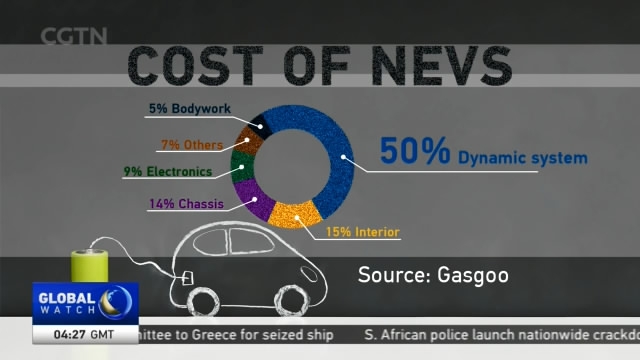
13:26, 24-Jan-2018
Alternative Fuel Vehicles: Reduced cost to boost China's NEV market by 2023

Working on striking a balance between economic growth and the environment, China is eager to bring back blue skies and one important strategy to achieve that is to leverage alternative energy technologies. As the largest market for automobiles in the world, China also has the biggest number of new energy vehicles, or NEVs, on the road. CGTN's Xu Xinchen has more.
This concept car that runs on electricity may be the future of the automobile industry. But before all cars look as good as this, vehicles powered by similar technologies are already on the market. New energy vehicles or NEVs are taking over Chinese streets.
ZHANG YICHAO, SENIOR PROJECT MANAGER ROLAND BERGER CONSULTANCY "We had a sales boom in the last quarter in 2017. Especially in December, we sold one hundred thousand units in China for the NEVs."
That also made the country the largest market for electric cars accounting for over one-third of the global sales.
XU XINCHEN BEIJING In addition to the rising consumer demand for new energy vehicles, the commercial use of green cars in China has also been huge.
Beijing Electric Vehicle or BJEV is the new energy car division for the state-owned carmaker -- Beijing Automotive Industry Holding. Sales doubled last year and half of their sales were for commercial use.
LIAN QINGFENG, SPOKESPERSON BEIJING ELECTRIC VEHICLE CO. "The commercial use of green cars such as rental cars and shared cars can get a better value out of new energy vehicles in their life cycles. And the performance of green cars in commercial use stands out quite well."
However, there is one concern. The Chinese government has been rolling out preferential purchasing policies and even credits to car makers that make green cars, in order to boost the development of NEVs. What will happen if all these policies are phased out?
ZHANG YICHAO, SENIOR PROJECT MANAGER ROLAND BERGER CONSULTANCY "There will be one critical trigger point, which is whether the total cost of the ownership of NEVs can be better than the traditional ICE vehicles."
The major cost of green cars still comes from its dynamic system, which includes the battery, motor and electric control systems. And Chinese car makers are spending four to five times in R&D on new energy technology compared to traditional cars. Once the cost for these systems can be reduced, the trigger point may come. But when will that be?
LIAN QINGFENG, SPOKESPERSON BEIJING ELECTRIC VEHICLE CO. "We estimate that around 2023, NEVs' competitiveness will surpass traditional vehicles especially in their long term value such as maintenance and operating costs."
In addition to maturing the technologies to support the future of green cars in China, infrastructure has also been built to meet the demand for charging. And other firms in China have developed the technology to swap batteries for electric vehicles within minutes. XXC, CGTN. Beijing.

SITEMAP
Copyright © 2018 CGTN. Beijing ICP prepared NO.16065310-3
Copyright © 2018 CGTN. Beijing ICP prepared NO.16065310-3